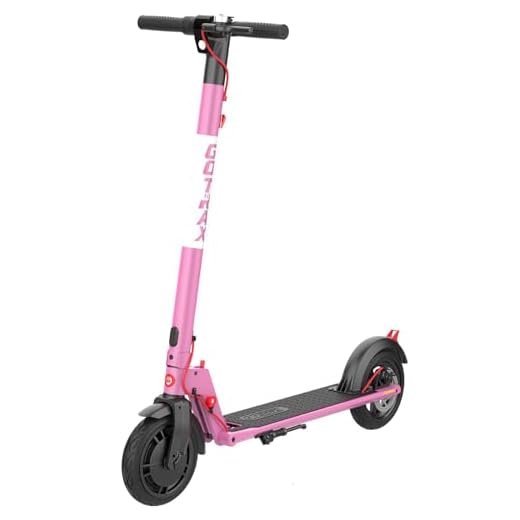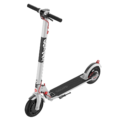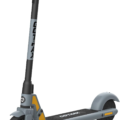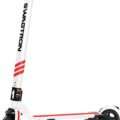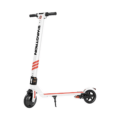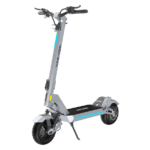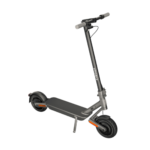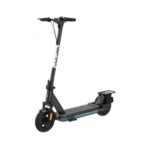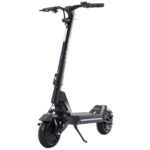- Home
- Scooters
- Electric Scooters
- Gotrax XR Ultra
Gotrax XR Ultra
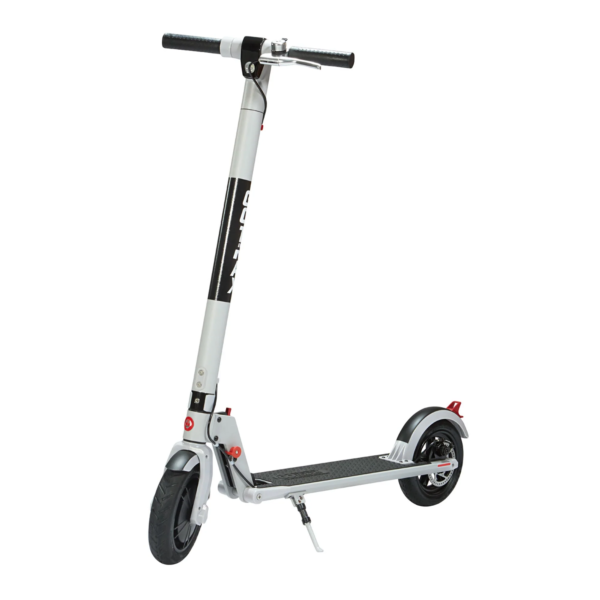

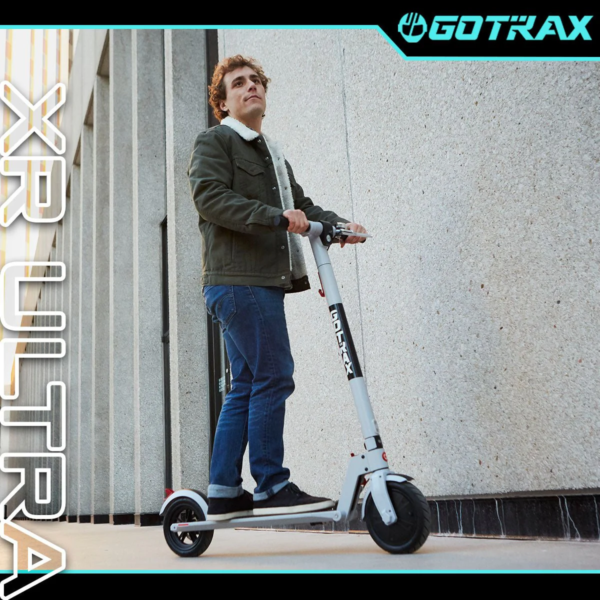
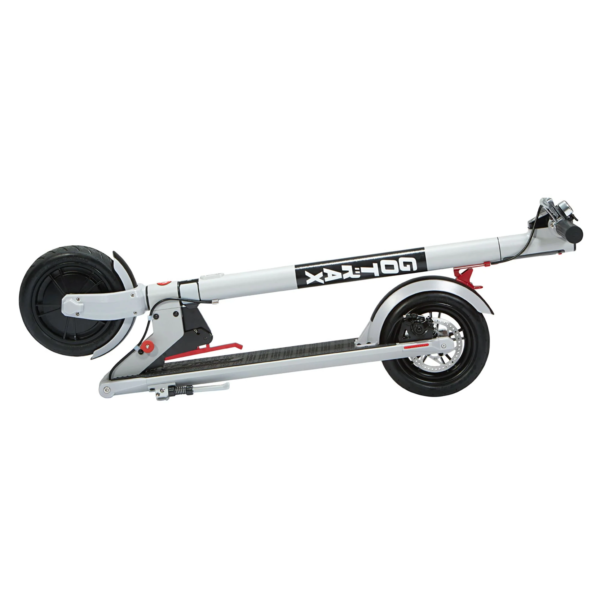
- Battery Range: 16 miles (25 km)
- Top Speed: 25 km/h (15.5 mph)
- Motor Power: 300 W rated
- Weight Capacity: 220 lb (100 kg)
- Charging Time: ~4 hours
- Scooter Weight & Portability: ~12.3 kg (27 lb)
PROS
- Lightweight design at just 27 lb — easy to carry
- Reliable dual braking system with regen + disc
- Pneumatic 8.5″ tires for a smoother ride
- Quick 4-hour charging time
- Cruise control for steady rides
- Compact folded size for storage
- Affordable price with LG battery cells for durability
CONS
- Shorter real-world range (11–13 miles) compared to 16-mile claim
- Limited top speed compared to higher-end models
- No app connectivity or built-in locks
- No suspension, rougher roads still felt
- Basic display with fewer features than premium scooters
Gotrax XR Ultra Overview
Introduction: A Lightweight Commuter Classic
Electric scooters have become essential for modern commuting. They cut travel costs, reduce pollution, and provide a fun way to navigate crowded streets. Among the many entry-level scooters, the Gotrax XR Ultra has stood out for years. Despite being introduced in 2019, it remains a top choice in 2025 for budget-conscious riders who want a balance of speed, portability, and reliability.
While other Gotrax models, such as the Gotrax G4 and Gotrax Apex XL, target commuters needing more speed and range, the XR Ultra appeals to those who value light weight and easy handling. It is designed for short to medium city rides, offering just enough power to keep up with bike-lane traffic while remaining compact and simple.
Motor and Speed: A Smooth Urban Ride
The XR Ultra comes equipped with a 300 W hub motor, delivering around 400 W peak output when needed. This power is modest compared to performance scooters, but it is well suited for urban commuting. Riders can reach a top speed of 25 km/h (15.5 mph), which matches the maximum allowed in many cities worldwide.
Acceleration is steady and predictable. The scooter pulls away smoothly at traffic lights, giving beginners confidence while still feeling responsive for experienced riders. On flat city roads, it maintains speed without struggle. Hills up to 15° are manageable, although riders may notice slower climbs at steeper sections, especially if they are closer to the 220 lb (100 kg) weight limit.
The rear-wheel drive provides stability and reduces the risk of wheel slip when accelerating on wet or dusty roads. For most daily commutes, the XR Ultra’s performance feels well-balanced.
Battery Capacity and Practical Range
Powering the XR Ultra is a 252 Wh lithium-ion battery pack, built with high-quality LG cells. On paper, Gotrax advertises a range of up to 16 miles (25 km). In reality, most riders report closer to 11–13 miles (18–21 km) per charge. Factors such as terrain, rider weight, and riding mode naturally affect the results.
For many commuters, this real-world range is enough to cover round trips without charging during the day. Someone traveling 4–5 miles each way will typically recharge the scooter every one to two days.
Charging is efficient, with the battery reaching full capacity in about 4 hours. This makes it easy to top up overnight or during work hours. The Smart Battery Management System (BMS) protects against overcharging, overheating, and voltage spikes, extending the life of the pack.
While it does not rival long-range models like the Gotrax G4, the XR Ultra’s range fits its role as a lightweight city commuter.
Ride Comfort and Handling
One of the key features that sets the XR Ultra apart from many budget scooters is its use of 8.5-inch pneumatic tires. Unlike solid tires, which can feel harsh over cracks and bumps, air-filled tires naturally absorb small shocks. This makes the scooter much more comfortable on uneven pavement, expansion joints, and light cobblestones.
The scooter does not include built-in suspension, so riders will still feel sharper impacts on rougher roads. However, the pneumatic tires strike a good balance between comfort and simplicity, requiring less maintenance than suspension systems while improving ride quality compared to solid tires.
The anti-slip deck provides a secure stance, and the fixed T-bar handlebars offer stability at full speed. Combined with its light frame, the XR Ultra feels agile when weaving through crowded bike lanes or navigating around obstacles.
Safety and Braking Performance
The Gotrax XR Ultra uses a dual braking system that combines:
- A front regenerative brake for smooth, energy-recovering deceleration.
- A rear mechanical disc brake for strong stopping power.
This dual approach ensures shorter braking distances while maintaining smooth control. Beginners can use gentle braking with the regenerative system, while experienced riders can combine both brakes for more aggressive stops.
The scooter also includes an LED headlight, a rear brake light, and reflective side panels. These safety features improve visibility in low-light conditions and make commuting after dusk more secure. For a lightweight scooter in this price range, the lighting and braking systems are impressive.
Portability and Folding Mechanism
Weighing just 12.3 kg (27 lb), the XR Ultra is one of the lightest Gotrax scooters designed for adults. This makes it ideal for riders who need to carry their scooter up stairs, load it into a car trunk, or bring it onto public transportation.
The one-step folding system is simple and quick. It uses a secure latch with a safety pin, ensuring the stem locks firmly in both riding and folded positions. When collapsed, the scooter’s dimensions are compact enough to store in tight spaces, whether at home, under a desk at work, or inside an apartment hallway.
Compared to heavier models like the Gotrax G4, the XR Ultra’s portability is a clear advantage for city riders who value convenience.
Build Quality and Durability
Despite being lightweight, the XR Ultra is built with a sturdy aluminum alloy frame. It feels solid underfoot, with minimal flex in the stem or deck. The scooter supports riders up to 220 lb (100 kg), making it suitable for most adults.
The scooter also carries an IP54 water resistance rating, which protects against dust and light rain. Riders should still avoid deep puddles or heavy downpours, but the scooter can handle typical urban weather without issue.
Features and Extras
The XR Ultra is a simple, entry-level commuter scooter, but it still includes a handful of useful features:
- LED Display — Shows speed, battery life, and riding mode.
- Ride Modes — Standard mode for range and Max Speed mode for performance.
- Cruise Control — Lets riders maintain speed on longer straight stretches.
- Accessories — Includes charger, manual, and Allen key for adjustments.
Unlike higher-end Gotrax scooters, the XR Ultra does not feature app connectivity or built-in anti-theft locks. However, its simplicity also means fewer electronics to maintain or troubleshoot.
Comparison with Other Gotrax Models
When comparing the XR Ultra to other scooters in the Gotrax lineup, it becomes clear where it fits:
- Gotrax GXL V2 — More affordable, but with slightly lower performance.
- Gotrax Apex XL — Similar portability but with a bit more range.
- Gotrax G4 — Higher speed and longer range, but heavier and less portable.
- XR Ultra — The sweet spot for riders who want light weight, modest range, and reliable performance at an affordable price.
In many ways, the XR Ultra is the commuter-friendly upgrade to the GXL V2, offering better battery quality (LG cells) and smoother acceleration.
Who Should Choose the Gotrax XR Ultra?
The XR Ultra is designed for:
- Urban commuters with short to medium daily routes
- Students who need a portable scooter for campus use
- New riders who want a stable, easy-to-learn scooter
- Budget-conscious commuters who still want pneumatic tires and dual brakes
If your commute is under 6–7 miles round trip and you value portability, the XR Ultra is a smart choice.
Maintenance and Ownership Tips
To keep the XR Ultra running smoothly, riders should follow a few basic maintenance steps:
- Keep the tires inflated to reduce flats and improve ride quality.
- Check the brakes regularly to ensure safe stopping.
- Charge the battery often instead of letting it drain completely.
- Store the scooter indoors to protect it from extreme temperatures.
These habits will extend the scooter’s lifespan and maintain performance.
Final Verdict: Lightweight, Reliable, and Affordable
The Gotrax XR Ultra has held its position as one of the best entry-level electric scooters for good reason. It offers a smooth 15.5 mph top speed, dependable real-world range, dual braking safety, and lightweight portability — all at a price that makes it accessible to a wide audience.
It is not designed for riders seeking extreme speed or long-distance range. Instead, it excels as a reliable, easy-to-use, and affordable option for city commuting.
In short, if you want a scooter that is simple, lightweight, and effective, the Gotrax XR Ultra continues to be one of the smartest buys in its class.
Specifications
General
| Model The Model specifies the exact version or name of the scooter. It helps identify its unique design, features, and specifications within the manufacturer’s product line. Knowing the model makes it easier to compare options, find compatible accessories, or look up support information. | XR Ultra |
| Brand The Brand identifies the manufacturer or company that designs and produces the scooter. A trusted brand is a sign of quality, reliability, and good customer support. Well-known brands often have higher standards for safety, performance, and after-sales service, giving you more confidence in your purchase. | Gotrax |
| Release Date The Release Date indicates when the scooter model was officially launched on the market. This helps you know how current the design, technology, and features are. A newer release date often means updated components, improved performance, and the latest safety or smart features. | 01 May 2019 |
| Recommended Age Recommended Age indicates the minimum age range that the scooter is designed for, based on safety, size, and ease of use. Following the recommended age helps ensure that riders can handle the scooter’s speed, weight, and controls comfortably and safely. Always check local laws and use protective gear, especially for younger riders. | 16+ years |
Performance & Power
| Motor Power (Wattage) What it means: The motor power, measured in watts (W), shows how strong the scooter’s electric motor is. Why it matters: Higher wattage usually means better acceleration, more torque, and improved performance on hills or rough terrain. For example, a 250W motor is good for flat city roads and light riders, while a 500W or 1000W motor provides more power for faster speeds or climbing steep inclines. | 300 W rated, ~400 W peak |
| Top Speed The Top Speed indicates the maximum speed that the scooter can reach under optimal conditions. It’s usually measured on level ground with a fully charged battery and an average rider weight. A higher top speed allows you to travel longer distances faster, but always ensure you ride within legal speed limits and your personal comfort zone for safety. | 25 km/h (15.5 mph) |
| Battery Capacity Battery Capacity refers to the total amount of energy the scooter’s battery can store, usually measured in ampere-hours (Ah) or watt-hours (Wh). A higher battery capacity means you can ride longer distances on a single charge, reducing the need for frequent recharging. Keep in mind that actual range can vary depending on rider weight, terrain, speed, and weather conditions. | 252 Wh (36V 7.0Ah lithium-ion, LG battery cells) |
| Estimated Range per Charge The Estimated Range per Charge indicates the average distance the scooter can travel on a single full battery charge. This range is calculated under optimal conditions, such as flat terrain, moderate speed, and average rider weight. Real-world range may vary depending on riding style, terrain, weather, and load. A longer range means fewer recharges and greater freedom for longer trips. | Up to 16 miles (25 km); real-world average 11–13 miles (18–21 km) |
| Hill Climb Ability Hill Climb Ability describes the maximum incline or slope that the scooter can handle while maintaining stable performance. It’s typically expressed as a percentage or in degrees. A higher hill climb rating means the scooter can tackle steeper hills without losing too much speed or power. Actual climbing performance may vary based on rider weight, battery charge, and terrain conditions. | Up to 15° inclines |
| Drive System The Drive System refers to how power from the motor is delivered to the wheels. Electric scooters typically use either a hub motor (directly integrated into the wheel) or a chain/belt drive system. A high-quality drive system ensures smooth acceleration, efficient power transfer, and low maintenance. The choice of drive system affects performance, noise level, and overall ride experience. | Rear-wheel hub motor |
Charging & Electrical
| Charging Time Charging Time indicates how long it takes to fully recharge the scooter’s battery from empty to 100% using the standard charger provided. Faster charging means less downtime and more time on the road. Actual charging time may vary slightly depending on battery capacity, charger output, and environmental conditions. | ~4 hours |
| Battery Type Battery Type refers to the specific technology used in the scooter’s battery, which affects performance, lifespan, weight, and charging time. Most modern electric scooters use high-quality lithium-ion (Li-ion) batteries because they offer a good balance of energy density, durability, and low maintenance. A reliable battery type ensures consistent power delivery and longer riding ranges. | Lithium-ion (LG cells) with Smart BMS protection |
| Removable Battery A Removable Battery means the battery pack can be easily detached from the scooter for convenient charging and replacement. This feature allows you to charge the battery separately, swap it with a spare for extended range, or securely store it indoors in extreme weather. Removable batteries add flexibility and make it easier to keep your scooter powered up wherever you are. | No |
| Regenerative Braking Regenerative Braking is an energy-saving feature that converts some of the energy normally lost during braking back into battery power. When you slow down or brake, the motor works in reverse to generate electricity, which helps extend the scooter’s range and improves overall efficiency. This system also reduces wear on traditional brake components, leading to lower maintenance over time. | Yes |
| Lighting Lighting refers to the built-in front and rear lights that enhance visibility and safety when riding in low-light conditions or at night. Good lighting helps you see the road ahead and ensures that other road users can see you. Many scooters include LED headlights, taillights, and sometimes brake lights or side reflectors for added safety and compliance with local traffic regulations. | Bright LED headlight, rear tail/brake light, side reflectors |
Build & Dimensions
| Scooter Weight Scooter Weight refers to the total weight of the scooter when fully assembled, including the battery. This affects how easy it is to carry, lift, and store the scooter when not in use. A lighter scooter is more portable and convenient for commuting, especially if you need to carry it upstairs or onto public transport. Keep in mind that a sturdy frame and quality components may add to the weight but also contribute to better durability and ride stability. | ~12.3 kg (27 lb) |
| Maximum Rider Weight Maximum Rider Weight indicates the highest rider weight that the scooter is designed to safely support while maintaining optimal performance and stability. Staying within this limit helps ensure reliable acceleration, braking, and climbing ability, and it protects the frame, suspension, and motor from excessive strain. Exceeding the recommended limit may reduce performance and increase wear on components. | 220 lb (100 kg) |
| Deck Size Deck Size refers to the dimensions of the scooter’s standing platform. A wider and longer deck provides more foot space, allowing you to stand comfortably and adjust your stance while riding. A well-sized deck improves balance and stability, especially on longer rides or at higher speeds. Compact decks, on the other hand, help keep the scooter lightweight and portable. | Anti-slip platform (~150 mm wide) |
| Handlebar Height Handlebar Height refers to the distance from the deck to the handlebars, which affects your riding posture and comfort. An appropriate handlebar height helps you maintain good balance, reduces strain on your back and arms, and makes steering more comfortable. Some scooters have adjustable handlebars to fit riders of different heights, while others have a fixed height for a streamlined design. | Fixed T-bar |
| Folding Mechanism The Folding Mechanism describes how easily and securely the scooter can be folded for carrying and storage. A well-designed folding system lets you quickly collapse the scooter into a compact size, making it convenient to transport on public transit, store under a desk, or fit into a car trunk. Look for sturdy latches and safety locks to ensure the scooter stays firmly in place when folded or unfolded. | Yes |
| Dimensions Folded Dimensions indicate the size of the scooter when it’s fully folded. This measurement shows how much space the scooter will take up when stored or carried, making it easier to check if it will fit in your car trunk, under a desk, or in a closet. Compact folded dimensions are ideal for commuters who need to bring their scooter on public transport or store it in tight spaces. | Compact for storage in trunks, offices, and apartments |
| Material Material refers to the primary construction materials used for the scooter’s frame and key components. High-quality materials like aircraft-grade aluminum, reinforced steel, or durable composites provide strength, stability, and a lighter overall weight. A sturdy material ensures the scooter can handle daily wear and tear while maintaining safety and performance. | Aluminum alloy frame |
Safety & Control
| Brake Type(s) Brake Type(s) describe the braking systems the scooter uses to help you slow down or stop safely. Common brake types include mechanical brakes (like drum or disc brakes), electronic brakes, and foot brakes. Many scooters combine multiple braking systems for added safety and shorter stopping distances. The type and quality of brakes affect your control, especially when riding at higher speeds or on slopes. | Dual: front regenerative brake + rear disc brake |
| Suspension Suspension refers to the system that absorbs shocks and vibrations while riding, providing a smoother and more comfortable ride over uneven or rough surfaces. Scooters may have front suspension, rear suspension, or dual suspension for better shock absorption and stability. Good suspension helps reduce rider fatigue and improves control, especially when riding on bumpy roads or off-road paths. | None |
| Tire Type Tire Type refers to the kind of tires the scooter uses, which directly affects ride comfort, traction, and maintenance. Common types include solid (airless) tires, pneumatic (air-filled) tires, or hybrid options. Pneumatic tires offer better shock absorption and a smoother ride on rough surfaces, while solid tires are puncture-proof and require less upkeep. The right tire type helps ensure safe handling and a comfortable ride in different conditions. | 8.5″ pneumatic air-filled tires |
| Tire Size Tire Size indicates the diameter and width of the scooter’s tires, which affect ride comfort, stability, and how well the scooter handles different terrains. Larger tires generally offer better shock absorption and a smoother ride over bumps and rough surfaces, while smaller tires keep the scooter lighter and more portable. Choosing the right tire size helps ensure a balance between agility and comfort. | 8.5″ (front & rear) |
| Kickstand The Kickstand is a built-in stand that allows you to park your scooter upright when it’s not in use. A sturdy kickstand keeps the scooter stable and prevents it from tipping over, protecting it from scratches and damage. It also makes storing and accessing your scooter more convenient, whether you’re at home, work, or on the go. | Yes |
| Water Resistance Rating Water Resistance Rating indicates how well the scooter is protected against water and moisture, usually shown as an IP (Ingress Protection) rating. This rating helps you understand whether the scooter can handle light rain, splashes, or wet roads without damage. While most scooters are not fully waterproof, a good water resistance rating adds peace of mind when riding in changing weather conditions. Always avoid deep puddles or submerging the scooter to protect its electrical components. | IP54 (splash resistant) |
Features & Extras
| Display/Console The Display (or Console) shows important real-time information about your ride, helping you monitor your scooter’s status at a glance. Typical displays show speed, battery level, distance traveled, and riding mode. Some models also include additional features like Bluetooth connectivity, app integration, or backlighting for better visibility at night. A clear and easy-to-read display enhances safety and convenience on every trip. | LED screen with speed, battery, and mode indicators |
| Ride Modes Ride Modes refer to the different speed and power settings you can choose to match your riding style or road conditions. Common modes include eco for maximum range and energy efficiency, standard for everyday balance, and sport or turbo for higher speed and stronger acceleration. Switching between ride modes allows you to customize performance, conserve battery, and ride safely in various environments. | Standard and Max Speed mode |
| Smart App Connectivity Smart App Connectivity lets you pair your scooter with a dedicated mobile app via Bluetooth. Using the app, you can monitor real-time ride stats like speed, battery level, and range, adjust settings such as ride modes or cruise control, lock the scooter for added security, and sometimes receive firmware updates. This feature adds convenience and allows you to personalize your riding experience right from your smartphone. | No |
| Anti-Theft System The Anti-Theft System helps protect your scooter from unauthorized use or theft. This feature can include built-in alarms, electronic motor locks, GPS tracking, or remote locking through a mobile app. A good anti-theft system provides peace of mind when parking your scooter in public spaces, adding an extra layer of security to safeguard your investment. | No built-in lock (requires aftermarket lock) |
| Cruise Control Cruise Control allows you to maintain a steady speed without continuously holding the throttle. This feature makes longer rides more comfortable by reducing hand fatigue and providing a smoother, more relaxed riding experience — especially on flat, open roads or bike lanes. For safety, cruise control can usually be easily activated or deactivated while riding. | Yes |
| Accessories Included Accessories Included lists the additional items that come with the scooter to enhance your riding experience and convenience. Common accessories may include a charger, kickstand, bell, lights, phone holder, or carrying strap. These extras add value by making your scooter safer, easier to use, and ready to ride straight out of the box. | Charger, manual, Allen key |
Warranty & Compliance
| Warranty Period The Warranty Period indicates how long the manufacturer guarantees the scooter against defects in materials and workmanship under normal use. A good warranty provides peace of mind, showing the brand’s confidence in its product quality. Always check what parts are covered, such as the frame, battery, and motor, and follow the maintenance guidelines to keep your warranty valid. | 12 months manufacturer warranty |
| Certifications Certifications confirm that the scooter meets specific safety, quality, and environmental standards set by recognized organizations or regulatory bodies. Common certifications may include CE, RoHS, UL, or other local compliance marks, depending on your region. These certifications ensure that the scooter is manufactured to high standards and is safe and legal to use in your country. | UL, CE, RoHS, IP54 compliant |



